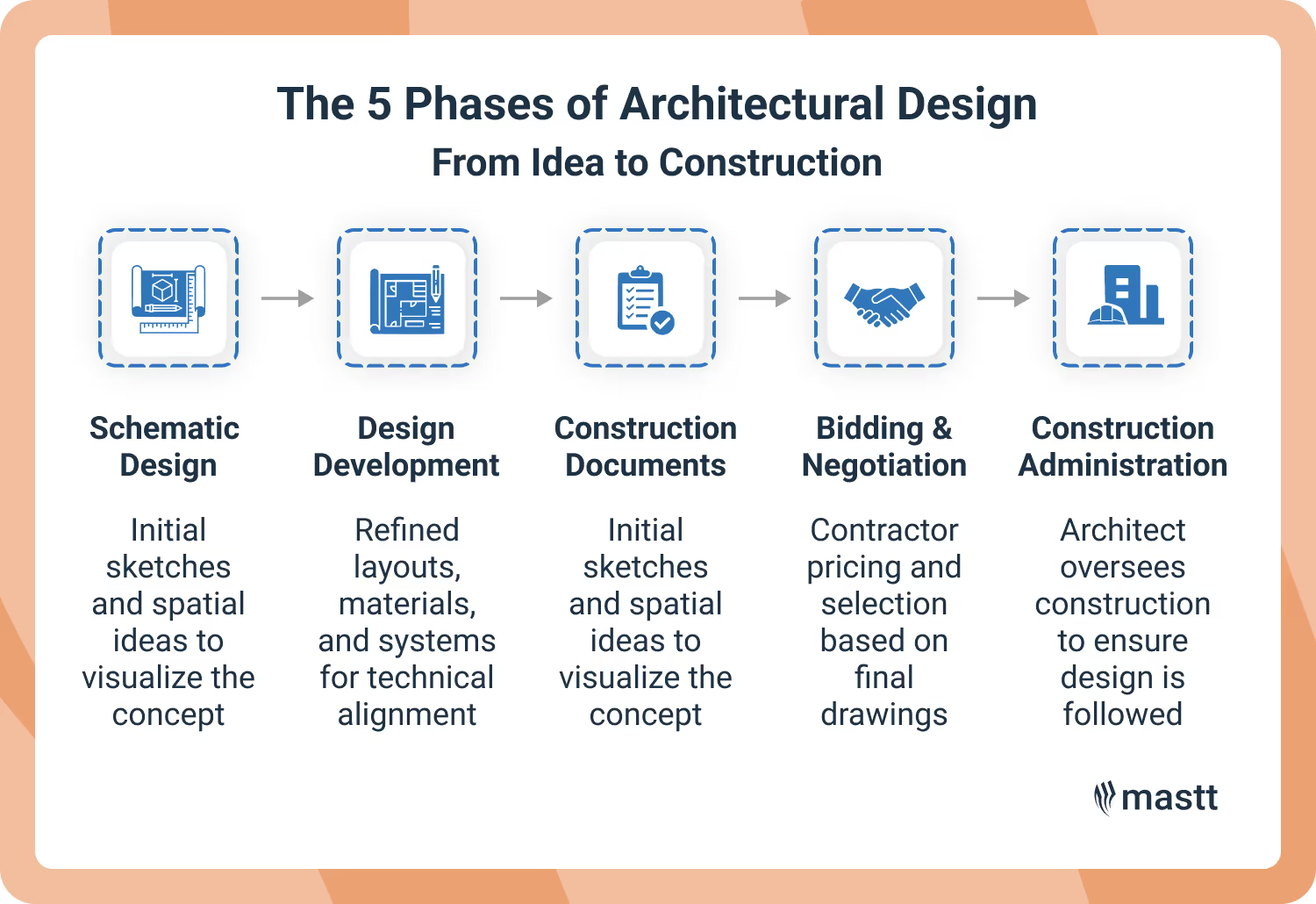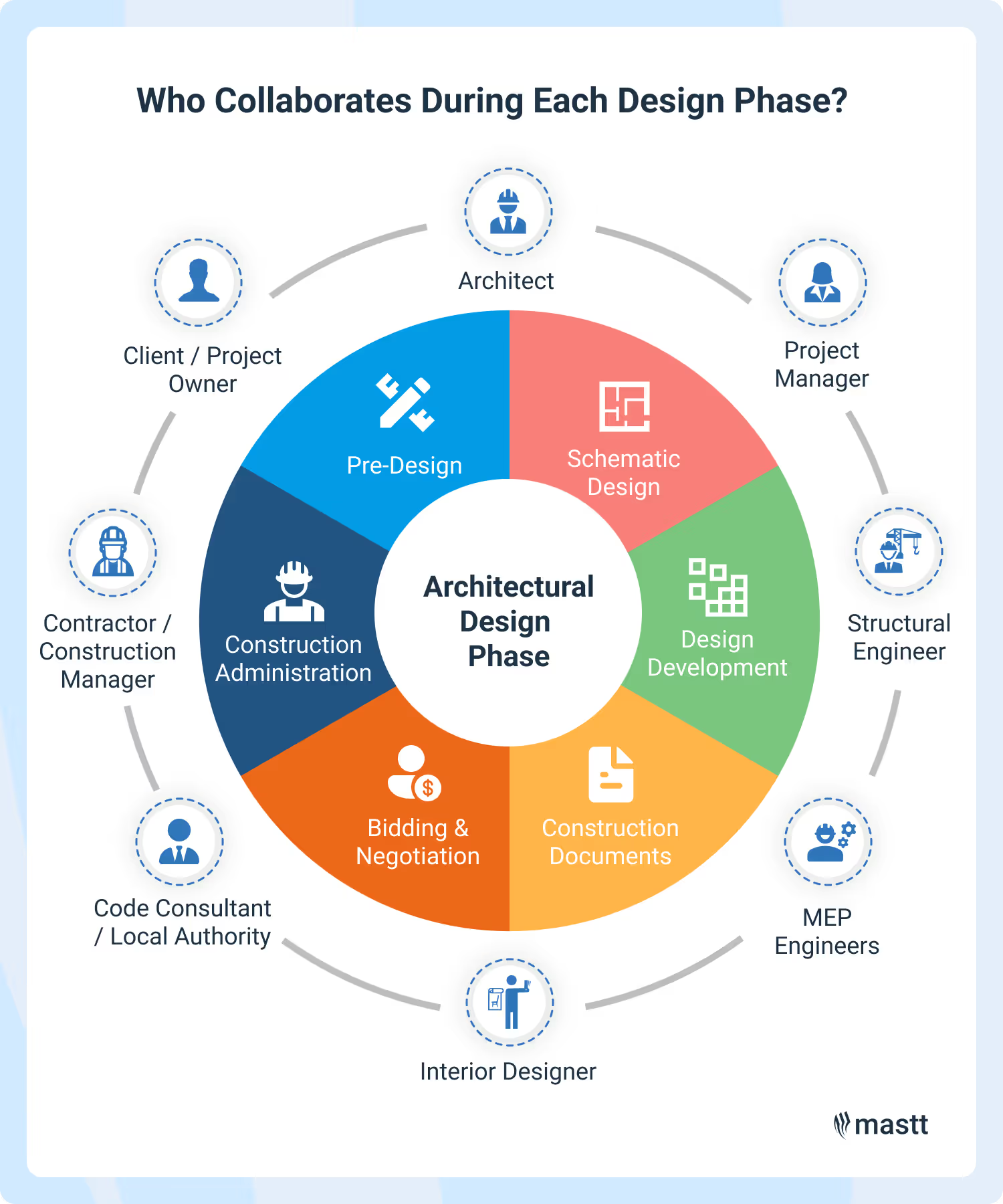Architectural design phases are the stages of building design. Learn how to manage each phase, track progress, and understand where time and fees are spent.

Use this FREE Project Timeline Template to plan, outline, and communicate your project schedule. Define key milestones and keep everyone aligned over the entire timeline.

In construction, design phases are the sequential stages that guide a project from concept to completion. Each phase helps turn ideas into buildable plans through coordinated work between architects, engineers, and clients.
In this guide, you’ll learn how the architectural design process is broken into clear phases, who’s responsible at every point, and how tools keep everything on track. This can be your practical framework for planning, tracking, and delivering smarter.
Architectural design phases are the defined stages of work that guide the design of a building from start to finish. They are a step-by-step framework architects use to organize the architecture design process of turning an idea into a built structure.
Each design phase represents a specific point in the project timeline, with clear goals, deliverables, and decisions. These phases of design help structure the architect’s responsibilities and ensure that the project design develops in an orderly, logical way.
The 5 phases of architectural design are standardized across the industry and used to communicate progress, coordinate the project team, and manage the design process efficiently.

The five main design phases of architectural design are the standard steps design professionals follow to move a project from concept to construction. Each phase serves a specific purpose and delivers key outcomes that shape the next stage in the design process. These phases form the core framework used in most architectural workflows and are detailed below.
Schematic design or SD is where the architect turns the client’s project goal into initial ideas, schematic drawings, and spatial concepts. This schematic design phase includes floor plans, rough elevations, and sketches that explore how the construction project might look and function.
Design development or DD takes schematic design ideas and turns them into more detailed design plans. Architects specify materials, refine room layouts, and coordinate systems like HVAC, electrical, and plumbing. This design development phase results in design development documents that align technical and aesthetic goals.
The construction documents or CD phase involves producing the technical plans and specifications used to price and build the project. This set includes construction drawings, schedules, mechanical drawings, and detailed notes that meet code requirements and guide the construction phase.
Bidding and negotiation involve sharing the construction documents with contractors to get cost proposals. The architect helps evaluate bids and answer questions so the client can choose a qualified builder.
The construction administration phase is the architect’s role during the build. They review progress, respond to RFIs, approve shop drawings, and ensure the construction aligns with the original design intent.
The value of these five design phases goes beyond organizing tasks. They reduce risk, improve communication, and help ensure the final building reflects the original vision. When followed closely, this structure supports clear decisions and smoother collaboration across the design team and project team.
The pre design phase is the stage before the formal architectural design phase begins. Architects use this time to gather the information needed to define the project program clearly. It’s when they ask questions, study the site, check zoning rules, and help the client figure out what’s possible.
The focus on pre-design is on research, discovery, and project scope definition. This programming phase often includes a site survey, a zoning analysis, and early conversations about space needs, timeline, and budget. A key output of this phase is design brief, a foundational document that summarizes the client’s goals, requirements, and constraints, guiding all future design decisions.
During this phase, architects may also help clients clarify their project scope, define their priorities, and identify risks early. The result is usually a document called a project program, which outlines all required spaces and their relationships.
Although essential, pre-design isn't considered one of the five main design phases defined by the . Those begin with schematic design, when actual conceptual design work starts.
Some countries treat pre-design as an official architectural design phase. This highlights how phases of design can vary globally. While the U.S. typically follows the five AIA phases, other countries introduce different labels, additional stages, or post-construction evaluations.
To see how these standards shape the architectural process, the table below compares the official design phases used in four major regions:
When teams understand how design phases differ by region, they make better decisions early. This matters most when coordinating across time zones, legal systems, or contract types.
Misunderstanding a phase label like “technical design” or “developed design” can lead to missed approvals, duplicated work, or gaps in construction documents.
For project management teams and construction consultants, learning the structure behind these standards is a tool for reducing risk, streamlining communication, and setting accurate expectations.
Every phase in the architectural design process depends on the right people doing the right work at the right time. Leadership shifts as the project evolves, and support roles move in and out depending on the deliverables, reviews, and technical depth required.
Design collaboration works best when each person understands their place in the design phases. Here's how leadership and support roles typically align:

Every role overlaps at times, but blurred lines usually point to missing coordination, not flexibility. If you’re leading a construction project, treat roles like signposts. A design team that knows their role can move faster and argue less.
Managing risk in architectural design means spotting issues before they affect scope, schedule, or documentation. The goal is to structure each phase to prevent delays. This starts by locking decisions early, aligning consultants on time, and building reviews into the schedule.
The most common risks and how to prevent them across architectural design phases are shown below:
Design risk is easiest to manage when the process makes gaps visible before they create problems. The best protection is a design process that flags unclear decisions, tracks deliverables, and locks scope at the right time. That’s how you keep control across every design phase.
Design changes happen on every construction project from client requests, site discoveries, or regulatory input. The goal isn’t to avoid change but to handle it without losing control of project scope, timeline, or project team alignment. Here’s how to manage changes once they enter the architectural design process.
A structured change process gives your design team a clear method for evaluating and responding to changes quickly across all design phases. Define who is responsible on how changes are reviewed, and what triggers formal evaluation. Make this workflow part of your overall project management and architectural process, not a side activity.
A live change log keeps everyone in the design process working from the same source. Document what changed, why it changed, and how it impacts construction drawings, budgets, or schedules. Link each update to formal approvals and make sure every entry is aligned with the relevant design phase, from schematic design to the construction documents phase.
Design updates should be shared in clear, actionable terms especially with the project team, consultants, and clients. Use visual markup tools and coordination platforms to illustrate what changed in the floor plan, schematic drawings, or mechanical drawings, and what steps follow. Real-time communication supports clarity across every architectural design phase.
Each approved change should be backed by formal documentation that captures its effect on the project program, contracts, and design deliverables. Link changes to updated architectural drawings, revised scopes, and altered design intent. Clearly map changes to affected design development documents or construction documents to ensure traceability across the entire architecture design and construction process.
🧠Expert Note: A clear revision narrative should explain what changed, why it changed and include a dated reference like “per client email 4/25/25.” It takes extra effort, but it’s essential for keeping reliable records.
Every approved change impacts the project design timeline. Update lookaheads, milestone dates, and review windows to reflect added scope or altered sequences. Adjust timelines across preliminary design to the design development phase to accommodate new work. Build in slack for critical deliverables such as permit submissions or construction document release to maintain momentum.
Even a small design shift can ripple through disciplines like MEP systems, structural components, and interior design finishes. Bring the structural engineer and other consultants into coordination sessions immediately after changes are approved. Reconcile new design options before resuming design development phase work or progressing into the construction phase.
🧠Expert note: For permit sets, show only what’s needed for code and zoning approval. Less info means fewer objections. Save the full detail for construction documents set.
Managing design changes is about control, not reaction. Keep your architectural design aligned by updating the documents, notifying the project team, and adjusting the schedule. That’s how you protect the integrity of the original design intent through every design phase, from the schematic design phase to the final phase of construction administration.
Architectural fees are divided across each design phase based on effort and deliverables. Most firms follow a percentage model tied to standard phases like schematic design, construction documents, and construction administration phase. These percentages reflect where the most time, coordination, and liability occur.
The typical fee distribution across design phases looks like this:
Fee percentages don’t tell the whole story unless you pair them with what’s driving the work. A high schematic design fee might reflect multiple design options, 3D renderings, or extended stakeholder input. A compressed CD phase with tight deadlines can spike coordination costs fast.
If you're managing fees, ask early how many architectural drawings, meetings, and revisions are actually expected in each design phase. The breakdown is a forecast of where your time will go and where your construction project is most likely to stretch.
Design phases create clarity around project scope, timing, responsibilities, and deliverables. They give architects, project managers, consultants, and clients a shared roadmap. Projects that succeed don’t just have a vision, they have a process that turns vision into action, one design phase at a time.

Cut the stress of showing up unprepared
Start for FreeTrusted by the bold, the brave, and the brilliant to deliver the future